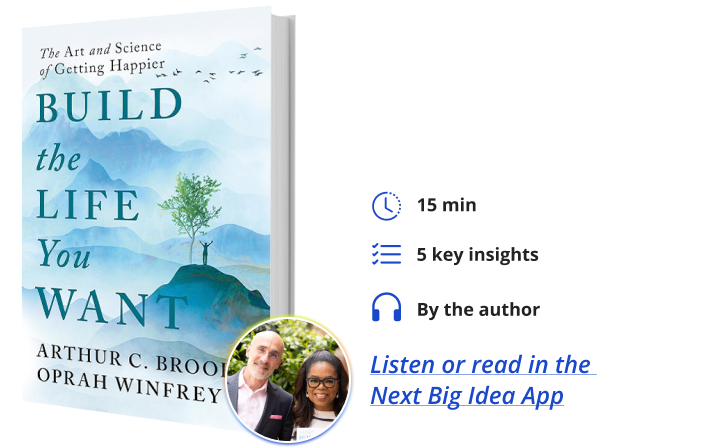Arthur C. Brooks is the William Henry Bloomberg Professor of the Practice of Public Leadership at Harvard Kennedy School and Professor of Management Practice at Harvard Business School, where he teaches courses on happiness and leadership. He is the creator of the popular “How to Build a Life” column at The Atlantic, an acclaimed public speaker, and the author of numerous bestselling books, including From Strength to Strength and Love Your Enemies.
As a global media leader and communications pioneer, Oprah Winfrey has built unparalleled connections with people around the world. Through The Oprah Winfrey Show, she entertained, enlightened, and uplifted millions of viewers for twenty-five years. Her accomplishments as a philanthropist and her commitment to books, reading, and education have established her as one of the most respected and admired public figures today.
Below, co-authors Arthur and Oprah share 5 key insights from their new book, Build the Life You Want: The Art and Science of Getting Happier. Listen to the audio version—read by Arthur—in the Next Big Idea App.

1. Happiness is not a feeling.
A lot of people say to me, I sure wish I felt happier. They think of happiness like they would any other feeling—but it is different. Just like the smell of turkey is not the same thing as the smell of Thanksgiving dinner. The smell of turkey is evidence of your Thanksgiving dinner, the same way your feelings of happiness are evidence of real happiness.
If happiness isn’t a feeling, what is it? It’s a combination of three psychological phenomena: enjoyment of life, satisfaction with life, and meaning in life. These are what we need to manage. We need to get beyond pleasure to achieve enjoyment. We must understand that satisfaction is something you can get, but is hard to keep. And to find meaning we have to figure out why things happen the way they do and determine the purpose and direction of our life.
Real happiness is within reach—if you understand that happiness is not a feeling, but a combination of enjoyment, satisfaction, and purpose.
2. Happiness is not a destination, it’s a direction.
The goal is not getting to happiness, but to get happier. This is because we need bad things in our lives. We need suffering and unhappiness so that we can understand what life is all about. We have positive emotions, and we have negative emotions. We like the positive ones, like joy and a sense of love and curiosity. These are basic emotions that, evolutionarily speaking, allowed us to get on with our lives, learn things, and live better. They’re nice.
But there are negative emotions as well, like anger, disgust, fear, and sadness. We don’t want these, but without negative emotions, we’d be in danger constantly. We would die. Negative emotions help us survive to enjoy nice things some other day. So, we should be thankful for negative emotions. If we didn’t have hard experiences, we wouldn’t know what life is all about. We wouldn’t understand resilience or have challenges that help us learn and grow.
“We need suffering and unhappiness so that we can understand what life is all about.”
We need negative emotions, we need negative experiences, but we also need to manage these things. When we learn to manage our emotions and experiences, then we can get happier. The goal is not happiness. Rather, we should be shooting for happy.
3. You can manage your feelings.
People don’t often feel that their emotions are out of control, even if they are kind of roaming around like kids running inside a house unsupervised. There’s a scientific reason for this.
Emotions proceed from a part of the brain called the limbic system. The limbic system has one real function, which is to translate the things that you perceive from your surroundings. It takes what can be seen, smelled, heard, and so on, and delivers that information to the most evolved human part of our brains: the prefrontal cortex. It is in the prefrontal cortex that you can decide how to react. For example, when something crosses your visual cortex, your limbic system senses it as something nice or something threatening—you feel an emotion. That emotion can then be perceived by your prefrontal cortex so you can decide what to do.
Understanding emotions in this way, emotions are not just nice to have or terrible to have. They are all worth appreciating because they are all signals. But you need to manage emotions by working harder to experience emotions in the prefrontal cortex more than through the limbic system. This is called metacognition, or being aware of what you are feeling. This can be developed through techniques like journaling, meditation, prayer, or therapy because these activities teach you about yourself and put space between your emotions, and how you react to your emotions. This is how you can manage the serious emotional business of you. In so doing, you can choose reactions, substitute emotions, or even disregard emotions. It will be your choice, not the emotions’ choice.
4. You have a distinct emotional personality.
Researchers have noticed that good and bad emotions are not opposites. It’s not that when you’re feeling happy, there is an absence of unhappiness. And unhappiness is not an absence of happiness. Positive and negative emotions can coexist, even intensively.
Some neuroscientists believe that positive and negative feelings are produced in different hemispheres of the brain. This means that you can have intense positive emotions and intense negative emotions. This is what we call the high affect person. This is a distinct personality type that we call the mad scientist, where everything is either intensely good or intensely negative.
“Positive and negative emotions can coexist, even intensively.”
On the other hand, you could be the kind of person who has intense positive emotions, but weak negative emotions. That’s what we call the cheerleader. Everybody wants to be the cheerleader, but the truth is that cheerleaders also have weaknesses. For instance, they don’t distinguish threats very well, they don’t like to hang around negative people, and they get surprised by bad news.
Another personality type is the poet, which are people who have very intense negative emotions and very weak positive emotions. A lot of people don’t want to be the poet, but it is also a very creative and romantic subtype, which is a real strength if managed accordingly.
Lastly, you can be weak on both sides, meaning weak positive emotions and weak negative emotions. This does not mean that you’re not happy when you’re happy or unhappy when you’re not happy, it means that the intensity of your emotions tends to be lower overall. This is called the judge. You’re unflappable, sober, and you’d make a good surgeon, or other intense, high-wire profession, like being a parent to teenagers. If you know your subtype, you can do a lot to manage it and surround yourself with people who help you and understand you.
5. Managing emotions helps build the four pillars of a happier life.
When people are out of control emotionally, they waste a lot of time. When people are anxious, or sad, and don’t know how to manage those emotions through metacognition and an understanding of their emotional subtype, then they tend to waste time trying to numb themselves. They distract themselves with social media, online shopping, and streaming Netflix, or whatever their thing happens to be. They don’t really enjoy it, but they fritter away their time hoping to feel better eventually. Once you get your emotions under control (which you can with a little bit of practice and a bunch of knowledge) you will find that you have a lot of time on your hands. This time can then be spent on the things that really matter.
Science tells us that to get happier and build the life you want, you have to build it on four distinct pillars: faith, family, friendship, and work. Faith does not necessarily mean a specific religious faith. It means a sense of philosophy, or way to perceive yourself in the grand scheme of things, and which gives you a sense of peace.
“You have to build [life] on four distinct pillars: faith, family, friendship, and work.”
The second is family life, the most mystical kind of love, the love you didn’t choose, but is so intense. Many people are walking away from their family relationships—which is a mistake. Unless there’s abuse, there’s no good reason to have a schism in your family relationships, especially over something silly like politics. You will not have the happiest life you can if you walk away from your family love.
Friendships matter too. The loneliest people have plenty of deal friends, but no real friends. Deal friends are useful. Your real friends are useless—beautifully useless.
Lastly, there’s work. Happiness at work is not about money, possessions, title, or prestige. It’s about two things only: earning your success and serving others by creating value with your life. These are the secrets to joy through work.
These are the four pillars on which you need to build the life that you want. Every day, put an investment into the accounts of your faith, your family, your real friends, and your work.
To listen to the audio version read by co-author Arthur Brooks, download the Next Big Idea App today:
































